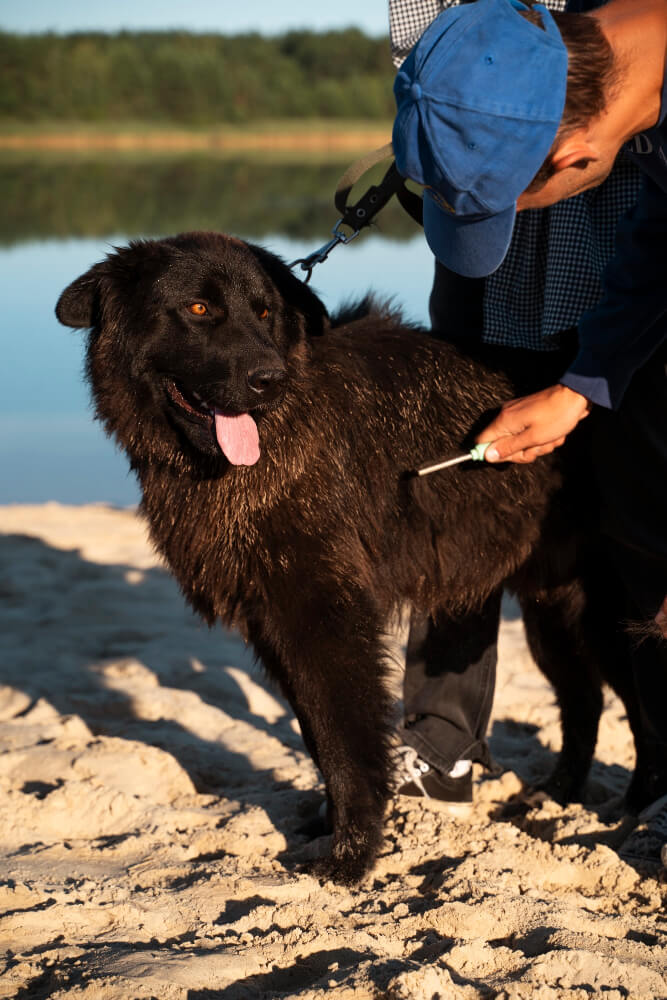As a dog parent, keeping your furry friend safe from pests like ticks is a top priority. One tick, in particular, the black-legged tick (also known as the deer tick), poses significant health risks to dogs. Let’s explore what these ticks are, the dangers they bring, and how to protect your dog from them.
What Are Black-Legged Ticks?
Black-legged ticks are small arachnids, about the size of a sesame seed, that thrive in wooded or grassy areas. They’re most active in spring, summer, and fall but can be a threat year-round in warmer climates. These ticks are notorious for transmitting diseases to both humans and animals.

How to Identify a Black-Legged Tick
- Size: Adults are tiny, about 3-5 millimeters, but they swell up after feeding.
- Color: They have reddish-orange bodies with black legs and a darker shield-like area near the head.
- Behavior: Black-legged ticks latch onto hosts like dogs by crawling up grass or shrubs and waiting for contact.
Why Are Black-Legged Ticks Dangerous for Dogs?
These ticks are carriers of several diseases that can severely impact your dog’s health:
- Lyme Disease:
- The most well-known illness caused by black-legged ticks.
- Symptoms include fever, lethargy, joint pain, and lameness.
- Anaplasmosis:
- Caused by a bacteria transmitted through tick bites.
- Symptoms include loss of appetite, fever, and difficulty walking.
- Babesiosis:
- A parasitic infection that attacks red blood cells.
- Signs include pale gums, dark urine, and weakness.
Symptoms of Tick-Borne Illnesses in Dogs
Keep an eye out for these warning signs if you’ve spotted a tick on your dog or know they’ve been exposed:
- Fever or lethargy
- Limping or stiffness
- Swollen joints or lymph nodes
- Loss of appetite
- Vomiting or diarrhea
If you notice any of these symptoms, consult your veterinarian promptly.
How to Check Your Dog for Black-Legged Ticks
After outdoor adventures, perform a thorough tick check:
- Inspect the entire body: Pay close attention to the ears, neck, underarms, and between toes.
- Feel for bumps: Run your hands over your dog’s coat to detect ticks you might not see.
- Use a fine-toothed comb: Especially helpful for dogs with thick fur.
How to Remove a Black-Legged Tick Safely
If you find a tick on your dog, here’s how to remove it safely:
- Gather supplies: You’ll need tweezers or a tick removal tool, gloves, and antiseptic.
- Grasp the tick: Use tweezers to grab the tick as close to your dog’s skin as possible.
- Pull steadily: Gently but firmly pull the tick straight out. Avoid twisting or crushing it.
- Clean the area: Wash the bite site and your hands with soap and water.
- Dispose of the tick: Place it in alcohol or flush it down the toilet.
Preventing Black-Legged Ticks on Your Dog
Prevention is key to keeping ticks at bay. Here are some effective methods:
- Tick prevention products:
- Topical treatments, oral medications, or tick collars are highly effective.
- Consult your vet to find the best option for your dog.
- Regular grooming:
- Bathing and brushing help spot ticks early.
- Avoid tick habitats:
- Keep your dog away from tall grass, dense shrubs, and wooded areas.
- Yard maintenance:
- Keep grass short and remove leaf litter to reduce tick-friendly environments.
- Vaccination:
- Some areas offer Lyme disease vaccines for dogs.

When to See a Vet
If a black-legged tick has bitten your dog and shows signs of illness, don’t delay. Early treatment can prevent serious complications. Your vet may recommend diagnostic tests, antibiotics, or other treatments depending on the condition.
The Bottom Line
Black-legged ticks pose a serious threat to your dog’s health, but with proper prevention and care, you can keep your furry friend safe. Regular checks, prompt tick removal, and protective measures are your best defense. If you have concerns or questions, reach out to your veterinarian for guidance.
Stay vigilant and enjoy outdoor adventures with your pup while staying tick-smart! For more tips and tricks on keeping your dog healthy, visit DogTalkBoy.








